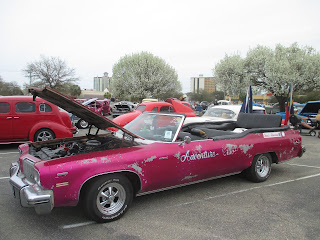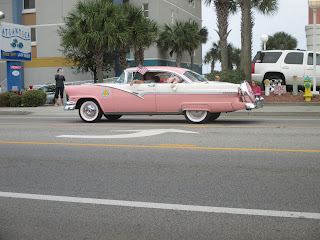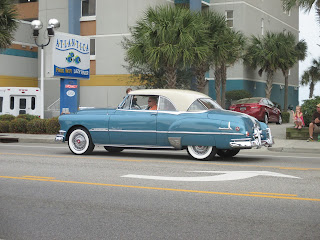Monday, March 7th - Monday, March 21st
We ate lunch at Raising Cane's in Charleston on our way to Myrtle Beach Monday, thanks to a gift card our kids sent us for Christmas. Yum, Yum! They have the best chicken ever. Thanks kids!
We got settled at Briarcliffe RV Resort and went for several walks along the beach and on the boardwalk while we were here. It seemed pretty nice at our campground, but was usually kind of windy and cool at the beach.
It was warmer the last time we went. If you are coming here for beach activities I would recommend waiting at least until the end of March. The Grand Strand refers to a virtually uninterrupted 60 mile stretch of beaches between Georgetown and Little River, South Carolina. Claude Dunnegan is credited with coining the term for his column From the Grand Strand in 1949 in the Myrtle Beach News. There used to be several large dance pavilions here along the boardwalk starting in the 1940s after WWII. Dancing at these pavilions on the beach evolved into the Shag, named the state dance in 1984. When we stayed at a campground in England, some friends we met there told us that shag means something quite different there. The last pavilion was closed and demolished in 2006. Now there are sand volleyball courts and carnival-type rides in their place.
Alligator about to have a poor little bunny for lunch. Happy Easter!
Pirate's Adventure Golf. There must be about 20 very elaborate miniature golf places here.
Seafood Buffets and shopping seem to be the other major activities.
There's also the wax museum, zip lining, tree top adventures and about a dozen theaters with concerts and variety shows. We went to a couple shows at the Carolina Opry that were pretty good.
We were driving down Ocean Boulevard Wednesday and I wasn't sure if John knew where he was going. But he told me not to worry, he had his GPS on and he knew exactly where he was going. We did eventually find the movie theater and went to see Eddie the Eagle. It wasn't a great movie, but it was a feel good true story and we enjoyed it.
The following Tuesday we went to Brookgreen Gardens. This is a red bud tree in the parking lot. William Allston, Jr. bought Brookgreen Plantation in 1764 and it became the basis of his wealth. Colonel Allston served under Francis Marion, the Swamp Fox, in the Revolutionary War. He died young leaving his wife, Rachel with six children and a plantation to manage. George Washington spent a night here at Brookgreen Plantation during his Southern Tour in 1791. Ownership passed to Joshua Ward in 1800. His son Joshua John Ward, born that same year, became the most successful of all the rice planters, known as The King of the Rice Planters. He was the 44th Lieutenant Governor of S.C. In 1850 the 9 plantations he owned, including Brookgreen, yielded 3.9 million pounds of rice on land cultivated by 1,092 slaves. He owned more slaves than anyone at that time, the only one to own over 1,000 slaves. He had eleven children and died in 1853. By 1860 his heirs owned 1,130 slaves. With the defeat of the Confederacy and the Emancipation Proclamation his empire quickly crumbled. His descendants lived here until 1931 when the Huntingtons bought what used to be four plantations (The Oaks, Springfield, Laurel Hill and Brookgreen). In 1801 Joseph Alston (they changed the spelling) inherited The Oaks Plantation and married Theodosia, daughter of Vice-President Aaron Burr. He was a member of the S.C. House for ten years, Governor from 1812 to 1814 and Senator 1814 to 1816. He is buried at the Oaks Cemetery two miles west and there is a memorial there for his wife and 10 year old son, Aaron Burr Alston, who were sailing to join her father in New York in 1812 when they disappeared off the North Carolina coast in a storm.
Portion of a bald cypress tree cut down in the 18th or 19th century during the creation of rice fields along the Waccamaw River. The original marks of hand axes used by slaves are still visible. The tree was at least 500 years old when it was cut down. Bald Cypresses grew as tall as 130 feet with diameters of 8 to 10 feet. Archer Milton Huntington, son of railroad magnate Collis Potter Huntington, was a Hispanic scholar, poet, patron of the arts and humanities and one of the wealthiest men in the U.S. In 1923 he married Anna Vaughn Hyatt, a prominent American sculptor. The Huntingtons bought Brookgreen and three other plantations in 1931 to create a public garden to display the works of Anna and her sister, Harriet, also a prominent sculptor. The gardens, sculptures, wildlife and petting zoo, several restaurants and other facilities are on what was originally Brookgreen Plantation. Beyond that there are nature trails, boat tours of the rice fields and driving tours of the family cemetery, archaeological digs and wildlife preserve. It is a National Historic Landmark, the country's first public sculpture garden and the largest collection in the world of figurative sculptures by American artists in an outdoor setting. Huntington State Beach across the road was also part of the original plantation.
As you walk along the boardwalk and path past the foundations of buildings long gone, there are audio panels that tell the stories of the lives and activities of those who lived on the plantation. There are these stainless steel, apparition-like sculptures of the slaves, overseer and owner along the way. It kind of seems like their ghosts are there telling their stories. The sculptures were done by Babette Bloch in 2006. Like most planters, Ward left his plantations during the hot summer malaria season for his seashore residence or mountain retreat, leaving his overseer in charge of day to day activities. His home in Charleston served as a stage for a round of balls and parties during the winter social season. In town a factor directed his business matters. Politically powerful rice plantation owners were among the wealthiest men in America. Ward owned Longwood, Springfield, Brookgreen, Prospect Hill, Alderly and Oryzanta plantations plus Rosehill Island, Clifton Island and Mitchell's Island all along the Waccamaw River. Carolina big grain rice was developed on his plantations, a forerunner of today's long grain rice.
There is a temporary exhibit of twelve LEGO brick sculptures throughout the Native Wildlife Zoo, by renowned artist and children's author, Sean Kenney, that is currently touring the country. They are made from almost a half million LEGO bricks. Kenney's work has been featured in The New York Times, The Wall Street Journal, BBC News and Good Morning America. He has created pieces for television shows, celebrities, tourist attractions and Fortune 500 companies. This is Pansy Bloom and Bee. Pansies were hybridized in the early 1800s from the wild violet. They are known as heart's ease in Europe and Johnny-jump-ups in America.
Galapagos Tortoise With Finch. Several species of birds known as Galapagos finches have symbiotic relationships with them. Tortoises move to provide access under their shells for finches to glean insects, providing food for the birds and insect control for the tortoises.
Hummingbird and Trumpet Flower, six foot bird hovering over flower. Hummingbirds are the only birds that can fly in any direction, including backwards, with 60 wing beats per second. Many weigh less than a penny and can migrate for thousands of miles and fly across the Gulf of Mexico.
Dragonfly, seven foot long giant dragonfly. The roseate skimmer is one of America's most beautiful large dragonflies. They breed in open mud-bottom ponds, slow streams or even sewage lagoons. Like all dragonflies, they are carnivorous as both underwater nymphs and flying adults, and so are beneficial insects for consuming many pests, including mosquitoes.
Peacock. The LEGO name is made from the first two letters of the Danish words LEG and GODT, meaning play well.
Herd of Deer, Buck, Doe and Fawn, 84,442 bricks used. The statewide white-tailed deer population is estimated at 725,000.
Grandfather Gardening With Child, 76,842 bricks used. A popular bonding activity for grandparents and their grandkids.
Monarch Butterfly on Milkweed in front of the butterfly house. There are 20,000 species of butterflies worldwide and over 150,000 species of moths. They both have 6 legs and 4 wings. Butterflies form a chrysalis and moths a cocoon. Butterflies rest with their wings closed and prefer to fly during the day. Moths rest with their wings open and prefer to fly at night.
Corn Spider. There are 915 million ways to combine 6 LEGO bricks. Really?
This is not a sculpture! Frequent signs throughout the gardens warn you to stay on the path. There are alligators, venomous snakes and stinging insects. Yikes! Alligators court in the spring in April and May. They bellow to each other and the male will blow bubbles underneath the female. Female alligators build nests and lay eggs in early summer. They build mounds of soil and vegetation over their nest which can contain 35 to 45 eggs. Most egg laying occurs in June and they incubate for 65 to 68 days. As the young hatch with high-pitched squeaks, the mother uncovers them and carries them to the water in her mouth. She guards her young for two or more years, even allowing them to rest on her back. There are 23 species of crocodilians throughout the world. The most seriously endangered species are in Asia.
Greeting the Dawn by Richard McDermott Miller 1993.
Thursday we headed downtown for the Myrtle Beach Run to the Sun Car Show, one of the largest car shows in the southeast, with several thousand classic cars. We walked up and down rows of old cars for about three hours. Then we walked a few blocks over toward the beach to watch the Cruise Down Ocean Boulevard.
Do not try to touch these cars. The sentries are on duty.
1938 Chevrolet 4-door Sedan Deluxe
Uh, oh. John just found that sweet Chevy Super Sport he gave up for me and a family. I wonder if he's having any regrets.
1958 Thunderbird Convertible For Sale $45,000. This guy tried to sell me his car. John was quickly by my side maneuvering me down the next row of cars. I don't get it, he always says I can buy anything I want. I guess there's a price limit.
Gotta love those interiors.
I've never seen so many guys spending so much time cleaning and polishing, but the way the pollen is falling, they probably need continual dusting.
Even "W" and Condi showed up for the fun!
Thieves Auto Parts Garage
Same Nite Service
The license plate on the middle one says "Her 401 K".
The trees are blooming like crazy and the tears are just running down my face from my itchy eyes.
Something for everybody. Maybe she's just jealous of her granddaughter and her Barbie car.
Adventure Club? Looks like a party car to me.
You might think this looks shabby, but it has been very artistically painted to look like natural fading over time.
1940 Chevrolet For Sale $25,000.
The hillbillies are here trying to sell the skins they have trapped.
This is just wrong. Using the name of the "King" on the side of porta-potties? What is this world coming to?
Vintage Street Rodders of America
Remember those fuzzy dice?
Ah, the family car. Let's take the kids to the Drive-in.
1940 Cadillac Limousine For Sale $45,000
Hooterville Rod Shop
Moon Car
These girls decided to join the fun with their little three-wheeled rental car.
The parade was so fun! People would yell out encouragement and the drivers would rev up their engines and peel out to lots of cheers!
What car show would be complete without the General Lee? Yee Haw!
Pro Mod 101
Honey Do Handy Man
Oh no, there it is again. Please don't cry John.
I sure hope these people are really short. But I bet it's pretty economical traveling and camping.
These guys were getting into the St. Patrick's Day spirit. Today was actually the day, but the partying started last weekend and will go through this weekend.
See the USA in your Chevrolet!
And they just kept coming.
So we called it a day and headed home.
Statue of Archer and Anna Huntington who established these lovely gardens. When you buy your ticket, it is good for 7 consecutive days. It really is too much to do in one day, so we came back on Friday.
This is the grave of a dog named Bruno who was buried here in 1888, still being well cared for.
Alligator Bender by Nathaniel Choate, 1937, a robust man carved in marble to look like a Seminole Indian. In the background is the 22 karat gold-gilded bronze, Dionysus, by Edward Francis McCartan.
I especially liked this one, The Wounded Comrade, by Carl Ethan Akeley 1913. The two elephants helping their friend, very touching.
Reaching by EvAngelos William Frudakis 1996.
Persephone by Marshall Maynard Fredericks, the Greek goddess of spring and the underworld. She was allowed to spend six months of the year in Hades (fall and winter) with her husband, Pluto, and six months above ground (spring and summer) with her mother, Demeter, goddess of harvest. She is depicted at the moment of her ascension from the world of the dead to the realm of the living, just as a plant sprouts below ground and emerges through the soil.
I used to love my garden,
But now my love is dead.
I found a bachelor's button
In my black-eyed Susan's bed.
Author Unknown
Riders of the Dawn by Adolph Alexander Weinman, 1942, Indiana limestone.
Brown Bears by Anna Hyatt Huntington 1935. This is made out of aluminum. She was the first sculptor to used aluminum and used it in a lot of her pieces. She started sculpting at age 13 and continued until her death at age 97.
The Tortoise Train by W. Stanley Proctor in the Children's Garden.
I think that I shall never see
A poem lovely as a tree,
Poems were made for fools like me,
But only God can make a tree.
Joyce Kilmer
Samson and the Lion, in the middle of the pool, by Gleb Derujinsky, limestone, 1949.
Diana by Augustus Saint-Gaudens 1893. Over 5,000 tulips are planted here in the Fountain Gardens.
Diana by Paul Howard Manship, companion to Acteaone below.
Acteaone by Paul Howard Manship 1924 depicts the myth of the unfortunate hunter who surprised Diana as she bathed in a woodland pool. Enraged, she turned him into a stag and he was killed by his own hounds.
The Fountain of the Muses by Carl Milles 1954 Bronze (15 pieces), finest sculptor of fountain groups in the 20th century, his last major work. Depicts the Greek myth of the fountain being sacred to the Muses because its waters provided creative inspiration for them. See all the yellow powder floating on the water? Pollen! Ah-chu!
Such a pretty place. Some thing we learned today, don't touch the Spanish Moss, it's loaded with chiggers.
Joy of Motherhood bronze by Willard Newman Hirsh. I love this one.
High Tides by Charles Cropper Parks 1985, known for his engaging portraits of children.
The last three are just for you, Barb.
The last three are just for you, Barb.
Eat More Beef by Sandy Scott, one of the county's leading animal sculptors. They have two small indoor galleries here with a temporary exhibit of her work. All birds and animals. They are wonderful.
Joy Ride by Charles Rudy 1933. Doesn't this look like fun? I understand they have a place in the Bahamas now where you can swim with the pigs and the tourists are going crazy for it. Robin said to tell John it looks safer than running with the bulls.
Orphans by Pietro Montana, black Belgian marble. Aren't they cute?
We had a late lunch at one of the restaurants here, she crab soup and quiche for me and fish and chips for John, and called it a day.
We left Monday for Selma, NC., about 30 miles from Raleigh, and on to Cape Hatteras next week. Doing our best to follow the pollen. Can't wait to go back to Arizona next year.
Tarra

















































































































































































No comments:
Post a Comment